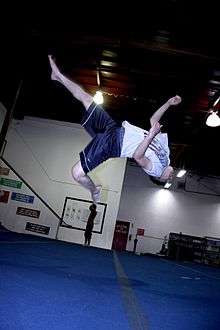Tricking (martial arts)

Tricking is a training discipline that combines kicks with flips and twists from gymnastics as well as many dance moves and styles from breakdancing. It aims to achieve an aesthetic display of different combinations of "tricks". Tricking practitioners are commonly referred to as trickers or tricksters. Examples of tricking techniques include the 540 kick, the flashkick, the butterfly twist and the double leg.
History

A tendency to exhibit techniques that are more flashy and complex was observed in martial arts during the period following the 1960s, predating the current tricking movement. Especially in taekwondo, an increasing emphasis on spectacular spinning, jumping or flying kicks developed during the mid-1960s with the introduction of international competitions.[1]
The actual sport of tricking is an internet phenomenon, emerging in the early 2000s. Xtreme Martial Arts is thought to be a close precursor to the sport, being shown at various martial arts tournaments in the 90s and early 2000s. By late 2003, the online tricking community was well-developed, bringing trickers from across the globe together. With the rise of YouTube, trickers were able to share their videos with others and the discipline experienced a massive rise in popularity and interest. Since the beginning of 2008, tricking has been receiving much wider publicity and popularity among the general public due to efforts of popular tricking teams.
Progression

Unlike many established sports, tricking has no formal rules or regulations, and there are no governing bodies that regulate the sport. Strictly speaking, participants are free to perform any kind of dramatic maneuver and call it a 'trick' - though there are certain moves which are generally accepted as tricking moves. Some practitioners (especially those who discover tricking through the Internet) tend to learn the easier moves first (such as the 540 kick, aerial, kip-up, and backflip) and try to progress through a list of recognized tricks in the perceived order of difficulty. However, how difficult a trick is varies from person to person; certain tricks may be inexplicably easier or harder than normal for a particular tricker to learn.
Trickers can be divided into different categories of style: some prefer performing mainly martial arts tricks (which almost always incorporate kicks into a trick), others mostly freestyle gymnastics and flips (mainly focus on combining different types of rotations and twists), but most trickers combine moves from both of the disciplines. Trickers regularly train their bodies hard to be able to consistently perform their tricks at any time.
Training

Due to tricking's relatively underground status, specialized training and coaching for the activity is almost non-existent. Some practitioners come from various martial arts and gymnastics backgrounds, however the majority of trickers are self-taught. In addition to martial arts and gymnastics foundations, trickers usually learn from friends or other individuals who have more experience than themselves. Many trickers, who do not have access to an environment with which to learn, train by simply reproducing movements seen in videos. A rising practice within the tricking community has been to form "teams" among friends. These groups serve not only as a form of self-encouragement for individuals, but also to build identity and credibility as a trickster in the community. Similarly, trainees seek aid from tricking camps and gatherings which expose trickers to other individuals with higher levels of skill. In recent years, tricking has had enough exposure to the point that some martial arts and gymnastics studios in big cities feature classes for it, .
Practitioners usually perform the majority of their tricks on grass or plyometric flooring. Foam landing mats, trampolines or jumping jamporees are utilized to become familiar with new movements in a safe environment. In addition to practicing the movements of tricking, many tricksters improve physical fitness to complement their training. A mutually common skill among many tricksters is body conditioning and strength training, as many of the movements within the activity require a high level of strength. Dynamic and static flexibility training is also commonly practiced by tricksters due to the high range of motion many tricks require.
Gatherings
Since its inception, gatherings have been a regular part of the tricking community. Organized by tricksters, usually with the assistance of online forums, gatherings are an opportunity for individual tricksters to showcase their styles and seek advice from other tricksters. Gatherings usually have one or more Gym Sessions, where a gymnastics studio is rented out specifically for the gathering.
In addition, there are also mini-gatherings (also known as seminars/sessions) that usually take place in grassy fields. Compared to regular gatherings where tricksters from all over the world attend, mini-gatherings generally attract local tricksters to a one-day session. This in turn allows local tricksters to meet, trick together, strengthen tricking in their own communities, and help expose it to more people in their local area.
In particular, the West Coast of the United States has a prominent community of tricksters, based mainly in Los Angeles, California.
Team tricking
Trickers sometimes make teams and practice together, but often perform together as well. Many teams choreograph demos which they then perform at events. Not only do the demos promote their teams, they also bring tricking out into the light for the rest of the world. Some trickers choose to pair up with other trickers at competitions and perform.
Media exposure
Since its rise in popularity, tricking has been featured in various media.
- Anis Cheurfa, a French professional trickster, portrayed the masked antagonist Rinzler in the 2010 film Tron: Legacy, utilizing tricking in combat.
- Jacob Pinto, a three-time Red Bull Tricking Champion, has been featured tricking in television, film and commercials, such as Best Time Ever with Neil Patrick Harris, Blackish and The Voice with CeeLo Green.
- Arrow, the DC television series played on the CW, showcased fight scenes by actress Caity Lotz, who portrays Sara Lance in the series.
- Daredevil, the marvel television series, showcased fight scenes which incorporated tricking as well as many other martial arts
- Got7, a South Korean boy group under JYP Entertainment is famous for using tricking as part of their choreography.
See also
References
- ↑ Green, Thomas A.; Svinth, Joseph R. (2010). Martial Arts of the World: An Encyclopedia of History and Innovation. ABC-CLIO. p. 202. ISBN 9781598842432.